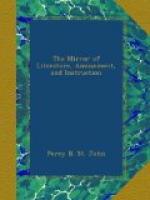CONSTANTINOPLE.
[Illustration: Constantinople]
“Queen of the Morn! Sultana of the East!”
The splendour and extent of Constantinople are not within the compass of one of our pages; but the annexed Engraving furnishes some idea of a section of this queen of cities. It extends from Seraglio Point to the Janissaries’ Tower, and though commanding only a portion of the city, includes the domes of the magnificent mosques of Santa Sophia and the Sultan Achmet, which rise from a vast assemblage of towers, palaces, minarets, &c. in every style of architecture.
We have so often and so recently touched upon the ancient and modern state of Constantinople, that we fear a recapitulation of its splendour would be uninviting to our readers.[1] Nevertheless, as its mention is so frequently coupled with the seat of war, and the “expulsion of the Turks from Europe,” our illustration will at this period be interesting, as well as in some measure, explanatory of the position of the city, which is so advantageous as to make it appear fit for the seat of dominion over the whole world. Can we then be surprised at its forming so tempting a lure to surrounding nations?
The city stands at the eastern extremity of Romania, on a neck of land that advances towards Natolia; on the south it is washed by the sea of Marmora, and on the north-east by the gulf of the Golden Horn. It is built, like ancient Rome, on seven hills, rising one above the other in beautiful succession, and sloping gently towards the water; the whole forming an irregular triangle, about twelve miles in circumference, the entire of which space is closely covered with palaces, mosques, baths, fountains, and houses; at a short distance the proudly swelling domes of 300 mosques, the tall and elegant minarets, crowned by glittering crescents, the ancient towers on the walls, and the gaudily coloured kiosks and houses rising above the stupendous trees in the seraglio, situated on the extreme point, form a rich, picturesque, and extraordinary scene. The gulf of the Golden Horn, to the north-east of the city, forms a noble and capacious harbour, four miles in length, by half a mile in breadth, capable of securely containing 1,200 ships of the largest size, and is generally filled with the curiously built vessels and gaily decorated boats of the Turks; on the opposite shore is the maritime town of Galata, containing the docks, arsenals, cannon founderies, barracks, &c.; above which stands the populous suburb of Pera, the residence of the foreign ministers of the Porte, and all foreigners of distinction, none whatever being allowed to reside in the city. Beyond, as far as the eye can reach, is an immense forest of cypress and mulberry trees, being the extensive cemeteries of all persuasions. From Galata, the European shore of the Bosphorus forms one continued line of towns; palaces in every style of architecture,




